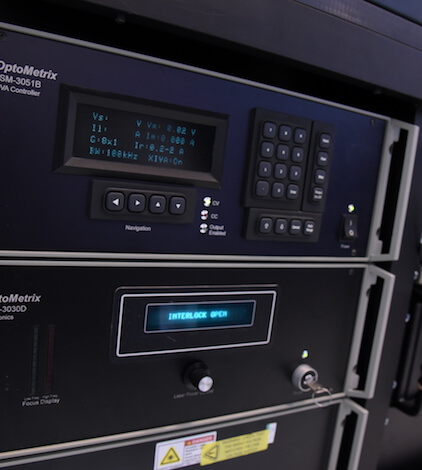Eternally induced voltage alteration (XIVA™) is a very effective laser injection fault isolation technique used to localize ohmic type defects and damage. XIVA™ is effective in localizing the following types of damage/defects:
Predecessor techniques to XIVA™ are optical beam induce current (OBIC), optical beam induced resistive change (OBIRCH), thermal induced voltage alteration (TIVA), seebeck effect imaging (SEI). However, there are distinct technical differences between XIVA™ and these afore mentioned techniques which makes XIVA™ the superior choice in fault isolation tools.
The XIVA™ system is comprised of the following major components:
XIVA™ is performed by setting up the DUT either stand alone or on an application board under the microscope; then position and focus the microscope on the DUT area of interest. When analyzing stand alone devices, electrical contact is made to the DUT with microprobes. Power is supplied to the DUT through the XIVA™ amplifier which provides a constant volage source through a XIVA filter. A 1340nm laser signal is scanned and stepped over a defined area of the device. Variations in voltage are plotted as colored pixels in the XIVA™ software on a scaled range of colors to indicate relative magnitude of changes in resistance in the DUT.
A key feature that makes XIVA™ a superior fault isolation technique is the XIVA™ filter. The primary role of the filter is to supply the required delta current resulting from laser signal modulating a physical point in the die for a given interval of time, but the key added benefit is the filter removes external pickup noise. With the removal of pickup noise, system sensitivity is significantly increased, resulting in a system and technique which is superior to it’s predecessors (LIVA, TIVA, OBIRCH, SEI, OBIC).
The XIVA™ system we use is manufactured by Quantum Focus Instruments Corporation. For more information on this system, you can visit their website at: QFI_XIVA

- Ohmic Shorts
- Shorted Metal Interconnects
- Silicon Conduction Paths
- Silicide Stringers
- Gate Shorts
- Junction Defects
- Open Via’s
Predecessor techniques to XIVA™ are optical beam induce current (OBIC), optical beam induced resistive change (OBIRCH), thermal induced voltage alteration (TIVA), seebeck effect imaging (SEI). However, there are distinct technical differences between XIVA™ and these afore mentioned techniques which makes XIVA™ the superior choice in fault isolation tools.
The XIVA™ system is comprised of the following major components:
- Laser source
- Galvanometer Scanner / laser scanner
- Microscope
- XIVA™ Amplifier
- Computer
XIVA™ is performed by setting up the DUT either stand alone or on an application board under the microscope; then position and focus the microscope on the DUT area of interest. When analyzing stand alone devices, electrical contact is made to the DUT with microprobes. Power is supplied to the DUT through the XIVA™ amplifier which provides a constant volage source through a XIVA filter. A 1340nm laser signal is scanned and stepped over a defined area of the device. Variations in voltage are plotted as colored pixels in the XIVA™ software on a scaled range of colors to indicate relative magnitude of changes in resistance in the DUT.
A key feature that makes XIVA™ a superior fault isolation technique is the XIVA™ filter. The primary role of the filter is to supply the required delta current resulting from laser signal modulating a physical point in the die for a given interval of time, but the key added benefit is the filter removes external pickup noise. With the removal of pickup noise, system sensitivity is significantly increased, resulting in a system and technique which is superior to it’s predecessors (LIVA, TIVA, OBIRCH, SEI, OBIC).
The XIVA™ system we use is manufactured by Quantum Focus Instruments Corporation. For more information on this system, you can visit their website at: QFI_XIVA



